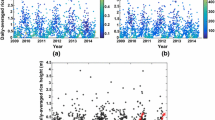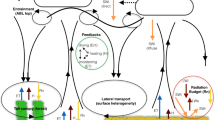Abstract
The Lhomme’s model (1988a), that extended Penmann's formulae to a multi-layer model, is redefined as a function of micrometeorological and physiological profiles of crop canopy. The sources and sinks of sensible and latent heat fluxes are assumed to lie on a fictitious plane called zero-displacement plane. Algorithms are given to compute sensible and latent heat flux densities. Performance of the algorithms is compared with that of earlier algorithms.
Similar content being viewed by others
References
Campbell G S 1977 An introduction to environmental biophysics; (New York: Heidelberg Science Library)
Chen J 1984 Uncoupled multi-layer model for the transfer of sensible and latent flux densities from vegetation;Boundary-Layer Meteorology 26 213–225
Choudhary B J and Monteith J L 1988 A four-layer model for budget of homogeneous surfaces;Q. J. R. Meteorol. Soc. 114 373–398
Deardroff J W 1978 Efficient prediction of ground surface temperature and moisture along with layer of vegetation;J Geophys. Res. 83 1889–1903
Lhomme J P 1988a Extension of Penmann's formulae to multi-layer model;Boundary-Layer Meteorology 42 281–291
Lhomme J P 1988b A generalized combination equation derived from a multi-layer micrometeorological model; Boundary-Layer Meteorology45 103–116
Monteith J L 1976 Vegetation and atmosphere. Vol. 2 Case studies. (London Academic Press) 33–62
Monteith J L 1981 Evaporation and surface temperature;Q. J. R. Meteorol. Soc. 107–127
Meyers T and Paw K T 1986 Testing of higher-order closure model for modeling air flow within and above plant canopies;Boundary-Layer Meteorology 37 297–311
Naot O and Mahrer Y 1989 Modeling microclimate-environment: A verification study;Boundary-Layer Meteorology 46 333–345
Penmann H L 1948 Natural evaporation from open water, bare soil, and grass;Proc. R. Soc. London A193 120–145.
Penmann H L 1953 Physical basis of irrigation control; Report 13th International Hort. Cong2 913–923
Perrier A 1976 Etude et Essai de Modelisation des Echanges de Masse et d'energie au Niveau des Couverts Vegetaux;These de Doctorat d'Etat, (Paris: Universite de Paris 6)
Shuttleworth W J 1976 A one dimensional theoretical description of vegetation-atmosphere interaction;Boundary-Layer Meteorology 10 273–302
Shuttleworth W J and Gurney R J 1990 Theoretical relation between foliage temperature and canopy resistance in sparse canopy;Q. J. R. Meteorol. Soc. 116 497–519
Waggoner P E and Reifsnyder W E 1968 Simulation of temperature, humidity, and evaporation profiles in a leaf canopy;J Applied Meteorology 7 400–409
Author information
Authors and Affiliations
Rights and permissions
About this article
Cite this article
Mohan, M., Srivastava, K.K. Computing energy budget within a crop canopy from Penmann’s formulae. J Earth Syst Sci 110, 179–184 (2001). https://doi.org/10.1007/BF02702217
Received:
Revised:
Issue Date:
DOI: https://doi.org/10.1007/BF02702217




